Global Photonics Market - Comprehensive Data-Driven Market Analysis & Strategic Outlook
The global photonics market ceased to be an obscure field of optical science and turned into a cornerstone of modern technology and communication. The road to success was not very easy, it originated in the early 1960s when the laser was invented, and then the industry started as a niche area of research considering light generation and transmission. However, over the years, it was able to get into and influence other areas such as telecommunications, medical diagnostics, and precision manufacturing. The late twentieth century marked the transition of information transmission using fiber optics; thus, the high-speed internet and digital connectivity emerged, which in turn transformed the whole of industries and societies.
- Global photonics market was worth around USD 1049.5 Billion in 2025, with a CAGR of approximately 6.8% throughout the year 2032, and the possibility of surpassing USD 1664 Billion.
- LED occupies almost a quarter of the market share, which can be credited to intensive research and development efforts that lead to the formation of new applications as well as innovative technologies.
- Mainly responsible trends for market growth: High-speed data transmission requirement in telecommunications users and healtcare practitioners adoption for diagnosis and treatment reasons.
- Potential includes the wide-ranging use of photonics in the new technology sectors like quantum computing and self-driving cars.
- One of the major points: the market size will be increased by cry when one looks backward one decade later, with the predominant growth driving factors being nothing but the upcoming technologies.
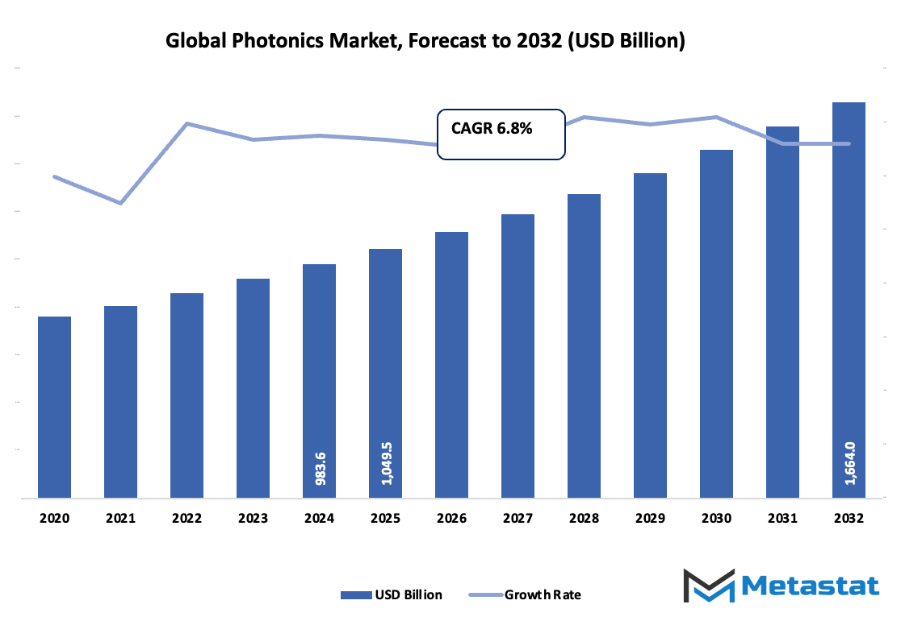
Initially, the global photonics market was mainly supported by research laboratories and military uses. The 1970s saw the coming of optical fibers, which was the first milestone of the market, making it possible to send data over long distances quickly and with a small amount of loss. The growth of personal computers and the internet made it necessary for photonics technologies to be involved in providing faster communication networks. The changeover from the analog to the digital system not only increased the demand for photonic components but also led to the development of new applications in imaging, sensing, and display.
The new millennium marked the start of a new era of growth. The consumer electronics industry began to integrate photonic sensors in cameras, displays and biometric systems. Medical imaging and laser-based treatments became the main application areas that heavily depended on this industry, thus, significantly extending its reach into areas outside of information technology. Both governments and private sectors started regarding photonics as a strategic resource and thus, they were willing to invest in projects that would connect academic research with the industrial world. The efforts contributed to the market moving towards miniaturization, integration, and efficiency.
Currently, it is a supporting base for the development of quantum communication, optical computing, and advanced manufacturing as the next-generation solutions. The changing consumer preferences for quicker data, high-resolution imaging, and eco-friendly technologies will keep on influencing its progress. The regulatory frameworks are also changing in this regard, as they are putting more stress on energy efficiency, data protection, and the safety of materials.
The saga of the global photonics market has been of mankind’s desire for precision and speed since its scientific developmental stage to general acceptance. Its narrative will continue as people’s ways of communicating through light-based technologies keep being redefined.
Market Segments
The global photonics market is mainly classified based on Type, Application, End-use Industry, .
By Type is further segmented into:
- LED: The LED technology will not only be the main contributor in the global photonics market but will also be based on its efficiency in power consumption and its long life. The application areas for LEDs in lighting, cars, and displays will still be going up. The transition to intelligent lighting solutions and the need for less power will be the reasons for LEDs getting more popular in different fields.
- Lasers, Detectors, Sensors, and Imaging devices: Laser, detector, sensor, and imaging device markets will be the leading sectors for the global Photonics industry. Major applications of these components include medical imaging, scientific research, and industrial processing. High precision, accuracy, and operation in hostile conditions are traits that will make it commercially and militarily attractive to have them around.
- Optical Communication Systems & Components: The market will benefit from optical communication systems and components as they will provide the means for quicker and more reliable data transfer. Fiber optic cabling and the accompanying components will be needed to increase the speed and capacity of networks. The growing internet access and the introduction of 5G will be the reasons for the greater demand for cutting-edge optical communication systems.
- Consumer Electronics & Devices: The category of consumer electronics and devices will keep on being a robust sector in the global photonics market. The image processing, display quality, and the power saving characteristics in smartphones, televisions, and others will all be due to Photonics-based innovations. The trend of upgrading camera sensors and display systems will be a contributor to the growth of this sector.
By Application the market is divided into:
- Measurement & Image Processing: Measurement and image processing will be a significant application area in the global photonics market. Photonics will allow high-precision measurements, quality inspection, and advanced imaging used in industries like healthcare and manufacturing. The demand for better visualization and real-time monitoring will continue to strengthen this field.
- Communication: Communication applications will drive a large portion of the market. Optical fibers and laser-based transmission systems will enable high-speed communication networks. The growing need for data centers, cloud storage, and broadband services will push the use of photonic components in communication infrastructure.
- Information Technology: Information technology will rely on the market to improve computing speed and data processing. Photonic chips and optical interconnects will be developed to handle large volumes of data efficiently. Their integration in IT systems will lead to faster and more sustainable computing solutions.
- Display: Display technologies will continue to benefit from the market. Photonic innovations will enhance screen resolution, brightness, and color accuracy for televisions, smartphones, and digital signage. The trend toward flexible and energy-saving display panels will also support market expansion.
- Lighting: Lighting applications will make a strong contribution to the market. Energy-efficient lighting solutions based on LEDs and lasers will replace traditional systems. The focus on environmental sustainability and reduced energy costs will keep the demand for photonic lighting technologies increasing.
- Defense & Security: Defense and security applications will utilize the market for surveillance, detection, and targeting systems. Photonics-based sensors and imaging tools will help in improving accuracy and situational awareness. Governments and defense organizations will continue to invest in photonic technologies for strategic purposes.
- Optical Components & Systems: Optical components and systems will support the structure of the market. They will be used in various devices for communication, imaging, and sensing. The improvement in lens design, fiber optics, and optical filters will create opportunities for better system performance and reliability.
- Photovoltaic: Photovoltaic applications will benefit from the market through the use of light-based technologies that enhance solar cell efficiency. Improved photonic designs will help capture more sunlight and convert it into energy. This progress will support the global push toward renewable energy sources.
- Other: Other applications of the global photonics market will include areas like printing, entertainment, and environmental monitoring. As new uses for photonics continue to appear, the market will see broader integration across various sectors. Continuous innovation will encourage growth and diversification of applications.
By End-use Industry the market is further divided into:
- Medical: The medical industry will rely on the global photonics market for diagnostic imaging, surgical tools, and therapeutic equipment. Photonics-based instruments will help improve accuracy and safety in treatments. Advancements in laser surgery and medical imaging will continue to drive this segment forward.
- Industrial: The industrial sector will benefit from the market through applications in automation, manufacturing, and quality control. Photonics will be used for cutting, welding, and precision measurement. The demand for accuracy and efficiency will encourage the use of photonic systems in production environments.
- Defense: The defense sector will use the market to strengthen surveillance, navigation, and targeting systems. Photonics-based technologies will enhance accuracy and detection capabilities. The focus on advanced optical sensors and secure communication systems will support ongoing development in defense operations.
- Consumer Electronics: Consumer electronics will continue to be an important part of the market. Photonic components will improve the performance of cameras, displays, and sensors in everyday devices. As user expectations for visual quality and device efficiency increase, this segment will remain vital to market growth.
- Media & Telecommunication: Media and telecommunication will rely on the market to handle high-speed data transfer and broadcasting. Optical fiber technology will ensure faster and more reliable communication networks. The demand for better connectivity and media transmission will maintain steady growth in this sector.
- Others: Other end-use industries in the global photonics market will include research, education, and environmental applications. These sectors will use photonic technologies for experiments, monitoring, and analytical work. Continued development and accessibility of photonic tools will expand their use in diverse fields.
|
Forecast Period |
2025-2032 |
|
Market Size in 2025 |
$1049.5 Billion |
|
Market Size by 2032 |
$1664 Billion |
|
Growth Rate from 2025 to 2032 |
6.8% |
|
Base Year |
2024 |
|
Regions Covered |
North America, Europe, Asia-Pacific, South America, Middle East & Africa |
By Region:
- Based on geography, the global photonics market is divided into North America, Europe, Asia-Pacific, South America, and the Middle East & Africa.
- North America is further divided into the U.S., Canada, and Mexico, whereas Europe consists of the UK, Germany, France, Italy, and the Rest of Europe.
- Asia-Pacific is segmented into India, China, Japan, South Korea, and the Rest of Asia-Pacific.
- The South America region includes Brazil, Argentina, and the Rest of South America, while the Middle East & Africa is categorized into GCC Countries, Egypt, South Africa, and the Rest of the Middle East & Africa.
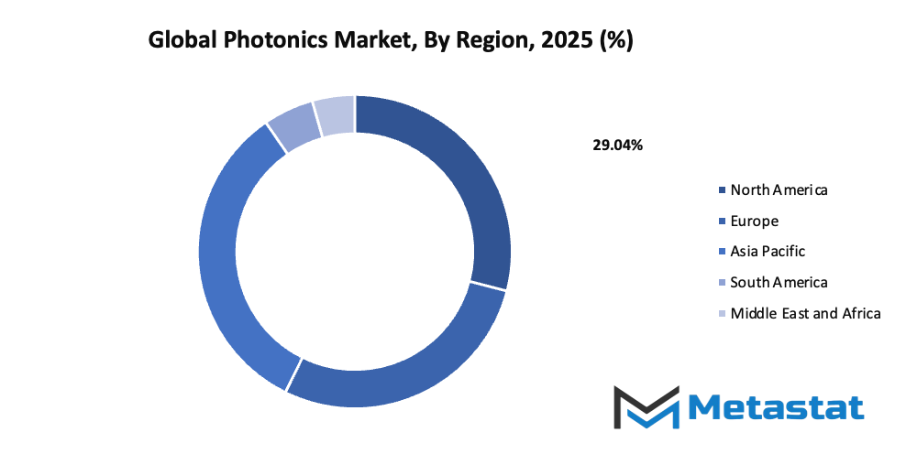
Growth Drivers
- Increasing demand for high-speed data transmission in telecommunications:The global photonics market will experience strong growth as the need for faster and more reliable communication networks increases. Photonics allows rapid transmission of large volumes of data using light signals, supporting technologies like 5G and fiber optics. The efficiency, low latency, and scalability offered by photonics make it vital for modern communication systems.
- Growing adoption of photonics in healthcare for diagnostic and therapeutic applications: The market will continue to expand as healthcare systems rely more on optical technologies for diagnosis and treatment. Applications such as laser-based surgeries, medical imaging, and biosensors enhance precision and improve patient outcomes. The ability to detect diseases at earlier stages through non-invasive methods also encourages wider adoption in medical facilities.
Challenges and Opportunities
- High initial investment costs associated with the development and deployment of photonics technologies: The global photonics market faces obstacles due to significant upfront costs in research, equipment, and skilled labor. Setting up advanced production facilities and maintaining accuracy in design requires large financial resources. These high expenses often limit participation from smaller companies, slowing overall market penetration and expansion.
- Challenges related to standardization and integration with existing systems in different industries: The market encounters issues in aligning new technologies with older infrastructure. Lack of universal standards causes compatibility problems across sectors like telecommunications, manufacturing, and healthcare. Consistent guidelines are necessary to ensure smooth integration, reduce inefficiencies, and encourage collaboration among technology developers and end users.
Opportunities
- Expansion of photonics applications in emerging fields such as quantum computing and autonomous vehicles: The global photonics market will gain momentum as research in advanced fields continues. Photonics plays a key role in enabling faster processing speeds for quantum computing and enhancing sensor accuracy for autonomous vehicles. These advancements open new possibilities for innovation, driving demand across industries and promoting long-term market growth.
Competitive Landscape & Strategic Insights
The global photonics market is progressing toward a future shaped by constant innovation, integration, and competition among both established leaders and new regional players. This industry represents one of the most dynamic sectors of advanced technology, where light-based applications are driving progress across multiple fields such as telecommunications, healthcare, manufacturing, and defense. As technology continues to advance, the demand for photonics solutions that deliver higher precision, efficiency, and speed will continue to expand, creating new opportunities and challenges for companies involved in this field.
The industry is a mix of both international industry leaders and emerging regional competitors. Important competitors include Hamamatsu Photonics K.K., Coherent Inc., IPG Photonics Corporation, Newport Corporation, Corning Incorporated, American Elements, Jenoptik AG, Trumpf Group, Lumentum Holdings Inc., Innolume, Molex Inc., One Silicon Chip Photonics Inc., Intel Corporation, NKT Photonics A/S, AIO CORE, SICOYA GMBH, and RANOVUS. These companies are shaping the future of photonics through breakthroughs in laser systems, optical components, semiconductor technologies, and fiber optics. Their research and development strategies focus on creating solutions that meet the growing needs of smart manufacturing, energy efficiency, and digital communication infrastructure.
As industries shift toward automation and data-driven systems, photonics will play an essential role in enabling faster data transfer and improved sensing capabilities. The continued expansion of artificial intelligence and quantum technologies will also rely heavily on advanced photonic devices. For instance, optical computing and photonic chips may soon replace traditional electronic processors, allowing faster and more energy-efficient data processing. This transition will likely redefine how industries function, from cloud computing to medical diagnostics, by reducing latency and enhancing performance at lower power costs.
The competitive landscape will evolve further as regional innovators challenge established global firms with cost-effective and specialized solutions. Start-ups focusing on integrated photonic circuits, miniaturized sensors, and optical interconnects are expected to influence market direction significantly. Collaborations between academic institutions and private companies will strengthen research capabilities and accelerate the commercialization of new technologies. Governments across different regions are also likely to increase funding and policy support for photonics, recognizing its strategic importance in national development and digital infrastructure.
Market size is forecast to rise from USD 1049.5 Billion in 2025 to over USD 1664 Billion by 2032. Photonics will maintain dominance but face growing competition from emerging formats.
Looking ahead, the global photonics market will experience steady growth driven by the increasing demand for connectivity, precision engineering, and energy-efficient systems. The companies leading this market will continue investing in innovation, sustainability, and global partnerships to secure a competitive edge. With ongoing advancements in optical technologies and materials science, photonics will remain at the center of future industrial transformation, supporting progress in communication networks, autonomous systems, and medical imaging. The balance between international leaders and emerging regional competitors will define the industry’s direction, ensuring that innovation remains continuous and accessible across global markets.
Report Coverage
This research report categorizes the global photonics market based on various segments and regions, forecasts revenue growth, and analyzes trends in each submarket. The report analyses the key growth drivers, opportunities, and challenges influencing the global photonics market. Recent market developments and competitive strategies such as expansion, type launch, development, partnership, merger, and acquisition have been included to draw the competitive landscape in the market. The report strategically identifies and profiles the key market players and analyses their core competencies in each sub-segment of the global photonics market.
Photonics Market Key Segments:
By Type
- LED
- Lasers, Detectors, Sensors, and Imaging devices
- Optical Communication Systems & Components
- Consumer Electronics & Devices
By Application
- Measurement & Image Processing
- Communication
- Information Technology
- Display
- Lighting
- Defense & Security
- Optical Components & Systems
- Photovoltaic
- Other
By End-use Industry
- Medical
- Industrial
- Defense
- Consumer Electronics
- Media & Telecommunication
- Others
Key Global Photonics Industry Players
- Hamamatsu Photonics K.K.
- Coherent Inc.
- IPG Photonics Corporation
- Newport Corporation
- Corning Incorporated
- American Elements
- Jenoptik AG
- Trumpf Group
- Lumentum Holdings Inc.
- Innolume
- Molex Inc.
- One Silicon Chip Photonics Inc.
- Intel Corporation
- NKT Photonics A/S
- AIO CORE
- SICOYA GMBH
- RANOVUS
WHAT REPORT PROVIDES
- Full in-depth analysis of the parent Industry
- Important changes in market and its dynamics
- Segmentation details of the market
- Former, on-going, and projected market analysis in terms of volume and value
- Assessment of niche industry developments
- Market share analysis
- Key strategies of major players
- Emerging segments and regional growth potential



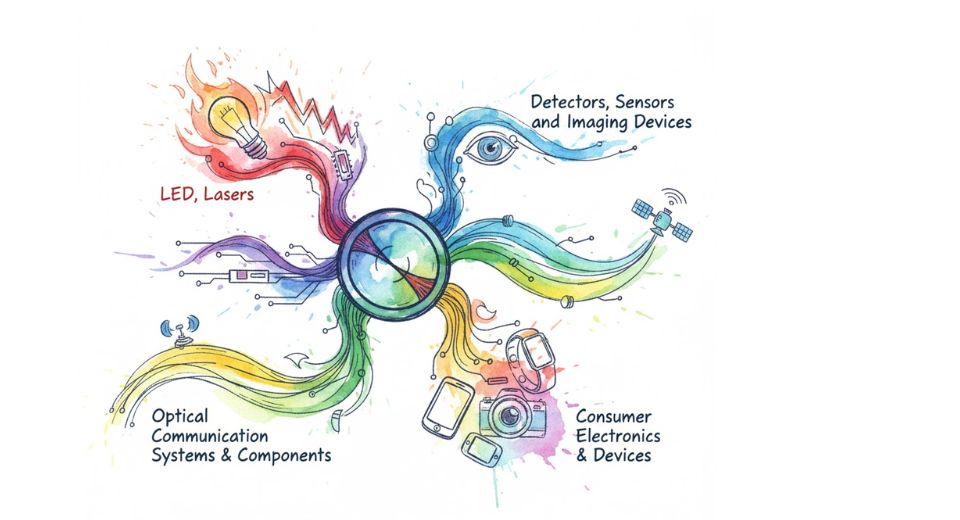
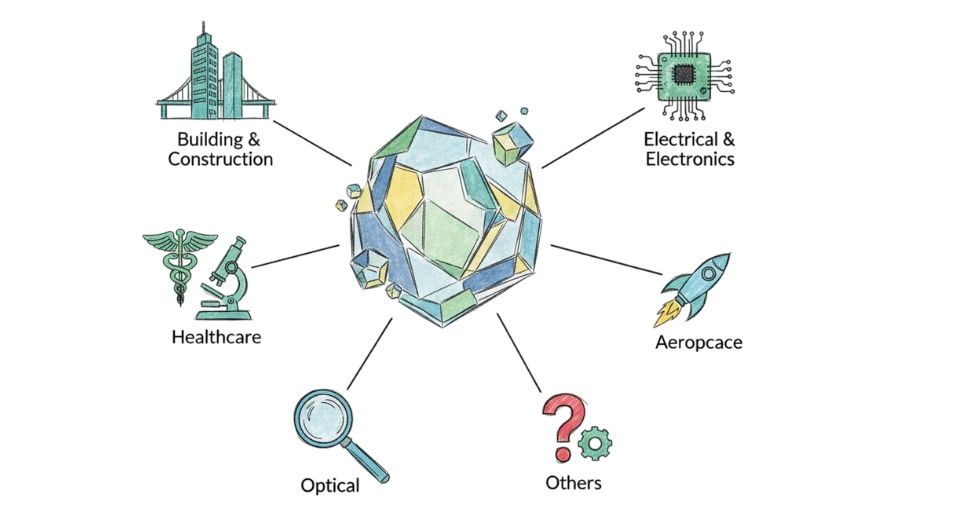

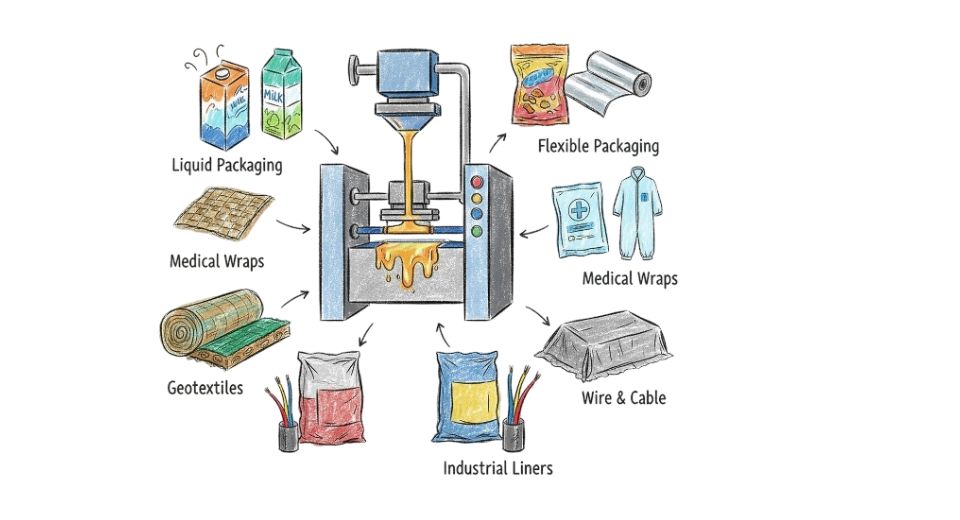

 US: +1 3023308252
US: +1 3023308252






